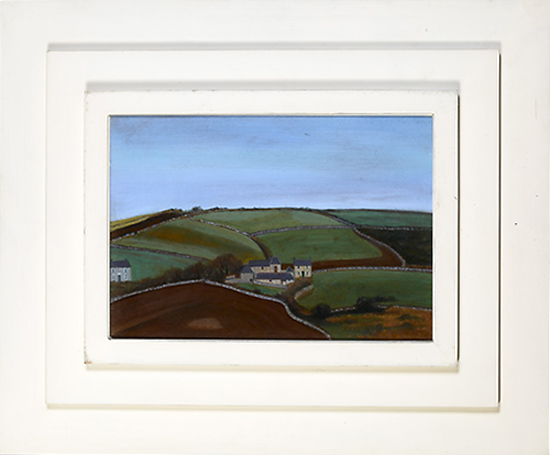

Gluck (1895-1978):
A Cornish Farmhouse, circa 1926
Framed (ref: 4783)
Inscribed (reverse) in the artist's hand 'Cornish Farm House' and signed 'Gluck'.
Oil on panel, 10 x 14 in. (25.4 x 35.6 cm.)
See all works by Gluck oil panel landscape 2.50 50 PART TWO WOMEN
Provenance: The Artist's Estate; Peyton Skipwith
In original Gluck frame.
The artist Gluck was the daughter of
Joseph Gluckstein, one of the founders Jo.Lyons & Co of Corner House
fame, and the American singer Francesca Halle. Refusing to follow
family conventions she insisted on becoming an artist and in 1916 she
made her first visit to Lamorna in Cornwall where she met Alfred
Munnings, Harold and Laura Knight and Dod and Ernest Proctor, later, in
the 1920s, buying the Knights' studio. Returning to London she was
befriended by Gordon Selfridge who gave her a studio in his store where
she painted 'one-sitting' portraits. She had her first solo exhibition
in 1924 at the Dorien Leigh Gallery, owned by the renowned photographer
E.O. Hoppé, whose iconic photographs of her with cropped hair, smoking a
cheroot and dressed in a Saville Row suit appeared in many magazines
(one was included in the recent Hoppé exhibition at the National
Portrait Gallery).
Gluck became a quintessential Art Deco
figure with major exhibitions at The Fine Art Society in the 1920s and
30s, designing her own frames - and even the gallery on one occasion -
working closely with Constance Fry, one of her many famous lovers, and
the architect Oliver Hill. During the 1930s she shared a studio in
Cheslea with the American painter Romaine Brooks, but towards the end of
the decade she gave up painting and devoted her time and formidable
energy to fighting a battle with all the paint manufacturing companies
of the world, claiming they were altering the composition of artists'
materials. Feeling vindicated she returned to painting and her 1973
exhibition at the Fine Art Society was a triumph, being hailed by
critics, museum curators and collectors, and firmly re-establishing her
reputation as one of the major figures of her period.
We are grateful to Peyton Skipwith for assistance.
 Unsung Heroines
Unsung Heroines Private collection
Private collection



